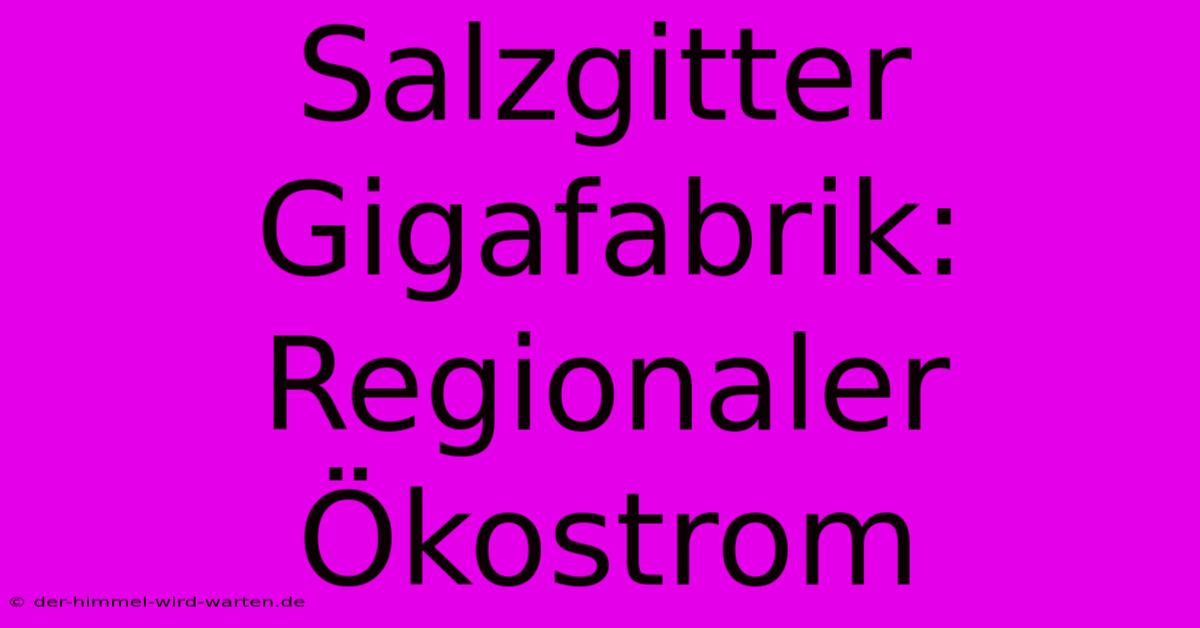Salzgitter Gigafabrik: Regionaler Ökostrom

Discover more detailed and exciting information on our website. Click the link below to start your adventure: Visit My Website. Don't miss out!
Table of Contents
Salzgitter Gigafabrik: Regionaler Ökostrom – Eine Erfolgsgeschichte im Werden?
Hey Leute! Let's talk about something super exciting and, frankly, a little complicated: the Salzgitter Gigafabrik and its ambitious plans for regional green energy. I've been following this project for a while now, and, man, there's a lot to unpack. It’s a huge undertaking, full of potential, but also some serious challenges.
I remember when I first heard about this – it sounded like science fiction! A massive battery factory, right here in Salzgitter, powered almost entirely by local renewable energy? Sounds amazing, right? Initially, I was totally on board, picturing wind turbines spinning merrily, powering electric vehicles of the future. But then I started digging deeper… and things got a little less rosy.
The Dream: 100% Green Energy for Gigafactory Production
The vision is pretty straightforward: to create a completely self-sufficient energy ecosystem for the Gigafabrik. This means drastically reducing the factory's carbon footprint and supporting the local economy through green energy jobs. That's the goal, anyway. Think of it as a huge, modern version of a self-sufficient farm, but instead of crops, they're making batteries! The plan hinges on utilizing local sources of renewable energy – solar and wind power primarily. Locally sourced electricity will minimize the carbon footprint of battery production.
Challenges of Regional Green Energy
But here’s where it gets tricky. While the idea is fantastic, the reality is… well, it’s more complicated than just sticking some solar panels on the roof. For one thing, the energy needs of a gigafactory are massive. We're talking truly enormous amounts of electricity, way more than your average town consumes. Finding sufficient, reliable sources of renewable energy within a reasonable radius is a huge challenge. Building enough wind farms and solar parks requires significant land use, and that always leads to some community pushback. I've seen articles discussing exactly these problems, and it's a real issue. There are also infrastructure challenges to consider; is the electricity grid robust enough to handle the influx of power? And even if they have enough electricity, can they actually store all of that energy when the wind isn't blowing or the sun isn't shining?
Practical Steps Towards Green Energy Success
Despite the hurdles, there are promising steps being taken. The focus on regional sourcing is crucial for minimizing transport-related emissions, a key factor in achieving a truly green operation. But simply stating a goal isn't enough; solid, long-term contracts with renewable energy providers are needed to ensure a stable energy supply. Furthermore, smart grid technologies will be essential for managing the fluctuating nature of renewable energy sources. Think intelligent energy storage solutions and possibly even partnerships with other local businesses that can utilize excess energy during periods of high production.
Beyond the Gigafabrik: A Regional Model?
The success of the Salzgitter Gigafabrik's green energy strategy could serve as a blueprint for other large-scale industrial projects. Imagine – a model that demonstrates the viability of a largely self-sufficient energy system, powered by local resources. It could be a game-changer. But it won't be easy. It needs thorough planning, careful execution, and maybe, just maybe, a little bit of luck. It’s a huge undertaking with the potential to really impact the region positively. I'm keeping a close eye on this one, and I hope it works out. The potential for job creation and environmental impact is just too big to ignore. What do you think? Let me know in the comments below!

Thank you for visiting our website wich cover about Salzgitter Gigafabrik: Regionaler Ökostrom. We hope the information provided has been useful to you. Feel free to contact us if you have any questions or need further assistance. See you next time and dont miss to bookmark.
Also read the following articles
| Article Title | Date |
|---|---|
| Verlustserie Dr Horton Was Nun | Dec 18, 2024 |
| Schwarzenegger Ergraut And Gluecklich | Dec 18, 2024 |
| Schwarzenegger Kaum Wiederzuerkennen | Dec 18, 2024 |
| Bali Zoo Elefant Von Flut Mitgerissen | Dec 18, 2024 |
| Weisse Weihnachten Nur Schwarzwald And Alpen | Dec 18, 2024 |
